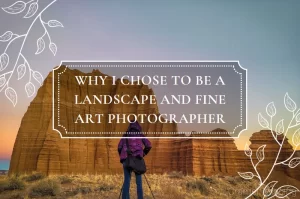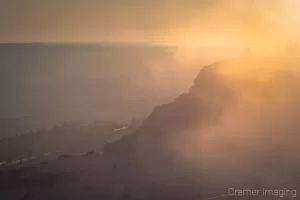10 Unexpected Items in the Landscape Photographer's Bag
Shop

Ever wonder what all I carry around in my camera bag? I know you’ve already thought of camera, lenses, filters, flash, and a few other camera-related accessories. There’s quite a bit more than that which I typically carry or keep handy. Here are 10 things which you might not think to find in a landscape photographer’s bag.
1. Cell Phone

Most people carry their cell phones around these days. It’s hardly surprising that a landscape photographer, such as myself, would have one such device on their person. However, did you know that a cell phone can be a valuable tool for a landscape photographer in the field? My phone sure is to me.
I use my cell phone for behind-the-scenes photos and videos when I’m out in the field. Some of those BTS photos I use frequently on social media were taken with my cell phone camera. I can’t exactly take a photo of my camera using my camera. I also use my phone for certain apps like tracking sunrise and sunset (golden hour). Also, I can quickly calculate when star trails will start and stop on the fly. I don’t want to do math in my head like that so my cell phone is great as a tool in the field.
2. Map/Compass/GPS

Since I’m a landscape photographer, I go out into wilderness areas to get my photos. This means that many of my landscape photography locations do not have and, therefore, cannot be found using a street address. I must take some form of direction-finding material if I want to find a formation or lake or something a bit off the beaten path. Maps and a compass have helped greatly as has the recent addition of a GPS.
I know I can get GPS apps on my cell phone to do some of this locating and tracking for me. Sometimes those apps work. This is when I get some form of cell signal. I’ve been to plenty of places where I don’t get a cell signal at all. Internet-based apps won’t work under those circumstances. That’s where a traditional map and compass come in. They work practically everywhere at any time and don’t rely upon cell signal.
3. Inverter

You might not think that I would find a use for a power inverter as a landscape photographer, but that’s where you’d be wrong. I have plenty of use for the cigarette lighter inverter with a traditional power plug outlet in my photography. It’s great for charging up my camera batteries in the car on the go. I occasionally find I have need of such a device so I carry one with me in my camera bag.
Have you ever needed an electronic device for one reason or another but the battery was too low or completely dead? I sure have. It can ruin a good photo shoot before it starts. I should be checking my batteries the night before and making sure that they are charged. However, not all my landscape photo shoots are planned. Sometimes, I just grab my camera and go. When this happens to coincide with a low camera battery, I use my inverter to charge up a battery on the way to the location.
4. Bug Spray

One of the hazards I face as a landscape photographer is the fact that bugs like to come out and swarm during one of my big windows for landscape photography: sunset. I don’t at all feel like being a meal for breeding mosquitoes nor do I like gnats buzzing about over my head just because I’m breathing out carbon dioxide which attracts them to me. For these very reasons, I carry a can of bug spray with me.
I’ve been out on photo shoots where I wouldn’t think I needed bug spray but I’ve been very glad to have it with me. Who would have thought that the mountains, away from large bodies of water, would have mosquitoes bothering me at sunset? It happened to me so I made a point of having some warding spray against bug bites in the future. My landscape photographer’s bag is truly incomplete without it at this point.
5. Pocket Knife

This particular item might really strike some people as being a very strange item for me to carry as a landscape photographer. Many people consider it to be strange and even dangerous to carry a pocket knife around. This, however, doesn’t make me a criminal. The pocket knife is a useful tool in many situations which is pocket-sized for our convenience.
A pocket knife is actually a very useful tool for me in the field. Pocket knives are used to cut things. Sometimes I find that I need to cut something in the field. Most of the time it’s something like a tree branch because said branch is obstructing my view and getting in my camera’s field of view when I don’t want it to. When times like this come up, I’m glad to have my handy pocket knife with me. However, there are other situations where my pocket knife has come in handy. When such times come, I’m very glad to have it with me.
6. Duct Tape/Masking Tape

Ok, so I don’t necessarily carry this particular item in my camera bag. It can get a bit bulky and heavy on hikes, especially extended ones. Still, I like to have some form of tape available should I need it. Usually tape rolls stay in the car unless I actually need them. Why tape? It’s for the same reason that we keep these kinds of tape around the house: because sometimes I need tape.
If I’m on a photo shoot, sometimes I actually need some tape. I could find I need tape for a field-expedient repair, to keep something in place, or many other possible uses in the field. Duct tape and masking tape are the two most useful kinds of tape for me to keep on-hand for such a need.
7. Snow and Ice Cleats for Shoes

As a landscape photographer, my photo shoot options are not limited to just spring, summer, and autumn. I can do winter landscape photos as well. These kinds of photos are best done with fresh-fallen snow as it’s still pristine. However, this does present a few problems. Walking on snow can be slippery, especially if there’s ice hidden under the newly fallen snow.
I carry a pair of ice cleats, which go over the soles of my boots in winter, for just that reason. They have given me the peace of mind to know that, when I’m hiking out on a popular trail covered in snow or photographing a lake at the edge of springtime, that I won’t be falling into a frozen lake or otherwise injuring myself if I lose my footing. I once watched my mother-in-law slip on some ice and get a concussion. No thank you.
8. Flashlight

Again, why would I carry a flashlight on a landscape photography shoot? Not all landscape photos are shot during daylight hours. Some are deep in dark caves. Dawn and dusk can be particularly dark too. When I need to see something or find something fast in my camera bag, I need a flashlight. A headlamp would do as well, but I don’t carry one since the flashlight is more compact.
Also, I hike into remote places for my photos. I want to be there when the light is perfect for a landscape shoot. This means that I have to either hike in or hike out in the dark. I prefer not to injure myself on a hike when I could have a flashlight to light the trail up for me instead. The right-sized flashlight won’t take up much space in my landscape photographer’s bag.
9. Hand Warmers

There’s a reason why landscape photographers bundle up for a winter landscape photo shoot. It’s because it’s cold. Standing out in the wind, snow, sleet, and other elements can really sap your body heat away. Layers help but don’t always do everything for those especially sensitive to the cold. That’s where hand warmers come in handy.
Also, camera equipment can get cold and freeze up. There isn’t a good way of thawing it out in the field other than my very moist breath (bad idea) or a portable heat source. Hand warmers are good for this task as well. They can help thaw glass (without adding moisture which will freeze and compound the problem) and thaw circuitry so I can get my photo taken. Bonus: a couple packets really don’t add much weight to my landscape photographer’s bag either.
10. Spray Bottle

Every so often, there is a special small detail which will snag my attention and seemingly beg for me to photograph it. It could be a flower, a mushroom, a leaf, a spider web, or anything else. While the original concept might be a passable photograph on its own, sometimes the photo needs something extra special to take the overall picture to the next level of greatness. This is where a handy dandy spray bottle comes in.
Many of the close-up or even macro images we find so amazing and over-the-top derive that spectacular quality from the fact that the subject matter is covered in water droplets of different sizes. This effect simulates the look of fresh rain fall on the subject matter. When out in the field, it is highly beneficial for me, as a photographer, to make some room in my camera bag for this essential non-camera accessory.
Conclusion
As a landscape photographer, I carry or keep handy a lot more tools and equipment than you might initially think I do. Some are for creature comforts. Most are utilitarian for my photo shoots as I run into interesting problems on site which I might not if I was a different kind of photographer. My “landscape photographer’s camera bag” is a lot bigger than it seems.
Best Sellers
Cramer Imaging Newsletter

Receive monthly updates in your inbox from us.





